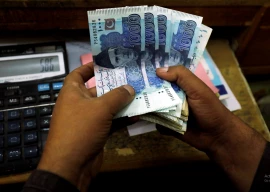
As the government struggles to find some fiscal space to reduce electricity prices, the finance ministry surprisingly said on Tuesday that inflation was heading towards single digit, in an assertion that was contrary to the central bank’s forecast of a double-digit inflation.
In its trimmed and sketchy monthly economic outlook, the finance ministry said that inflation was expected to be in the range of 12-13% in July 2024 – a band that was broadly in line with the current trends. It predicted a further slowdown to 11% in August.
However, in a surprising claim, the finance ministry stated that “inflation is heading towards single digits”. The ministry did not elaborate its claim of single-digit inflation.
A day ago, the State Bank of Pakistan (SBP) said in its monetary policy statement that based on the current trends – and accounting for the sufficiently tight monetary policy stance and ongoing fiscal consolidation – the average inflation was expected to remain in the range of 11.5-13.5% in fiscal year 2024-25.
The central bank’s upper limit of inflation was higher than the government’s annual inflation target of 12%. Even the publications of international financial institutions are putting Pakistan’s inflation rate around 15% for the current fiscal year.
The high inflationary expectations are due to a significant increase in electricity prices and the tax-loaded budget for the new fiscal year. The government had proposed to defer the increase in electricity prices for the consumers of 201 to 400 units in a month but the International Monetary Fund (IMF) shot down the proposal.
Sources said that officials of the Ministry of Finance and the Ministry of Energy were now considering other options to reduce the capacity payments but so far they had not been able to come up with a viable plan.
The central bank had stated that the inflationary impact of the fiscal year 2025 budget was largely in line with expectations and the available information indicated that the full impact may take some time to reflect in domestic prices.
However, it said that there were risks to the inflation outlook from fiscal slippages and ad hoc decisions related to the energy price adjustments.
In its monthly report, the Ministry of Finance said that exports and imports would continue to demonstrate an increasing trend in July. Exports may range from $2.4 billion to $2.7 billion – a band that was not sufficient to keep Pakistan out of the IMF loop in the longer run.
The ministry predicted monthly imports in the range of $4.5 billion to $4.9 billion.
The finance ministry did not give a comprehensive review of the economic outlook. It said that the agriculture sector growth target was set at 2% for FY25. Owing to a high base in the previous year, important crops and other crops are projected to keep a reasonably good pace of growth in 2024-25.
Furthermore, livestock, fishery and forestry are projected to continue to be on the growing trajectory due to a favourable and encouraging environment. The recovery that began in large-scale manufacturing will likely continue throughout FY25, driven by a stable exchange rate, macroeconomic stability and relaxed import restrictions. Revived domestic economic activities, better agricultural output, stable exchange rate, improved foreign demand and low global commodity prices would remain instrumental in external sector stability, it added.
But the central bank said that economic growth may remain in the range of 2.5% to 3.5%, dropping the first hint that this year’s growth target may also be missed.
The finance ministry said that Pakistan’s economy moved towards stability in FY24 with a decreasing inflation, surplus in the primary fiscal account, negligible current account deficit and stable exchange rate, it added. The external account position improved due to a tangible increase in exports and remittances.
However, the ministry said that foreign direct investment remained at only $1.9 billion in the last fiscal year. The figure is quite low despite the setting up of the Special Investment Facilitation Council that has now been converted into a regular division of the federal government.
In spite of the tight monetary policy, the money supply in the market increased 15.5%, thanks to the federal government that remained overwhelmingly the single largest borrower.
“Despite a high policy rate, the money supply grew,” said the ministry, adding that the increase was driven by the growth in the banking sector's net foreign assets by Rs540.6 billion. Net domestic assets grew Rs4.4 trillion.



















COMMENTS
Comments are moderated and generally will be posted if they are on-topic and not abusive.
For more information, please see our Comments FAQ